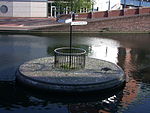Roundhouse, Birmingham

The Roundhouse, formerly Corporation Wharf, is a crescent shaped building located in the city centre of Birmingham, England. Originally used as a local authority depot, stables and stores the building is now in the care of Roundhouse Birmingham, an independent charity created by the National Trust and Canal and River Trust. Roundhouse Birmingham delivers a year-round programme of walks and tours that launched in 2021. Tours include kayaking, cycling, walking and stand up paddleboarding. The Roundhouse is a rare survival of a relatively unaltered 19th century complex of functionally related buildings dating from Birmingham's industrial and civic heyday. The building is Grade II* listed.
Excerpt from the Wikipedia article Roundhouse, Birmingham (License: CC BY-SA 3.0, Authors, Images).Roundhouse, Birmingham
Sheepcote Street, Birmingham Ladywood
Geographical coordinates (GPS) Address Nearby Places Show on map
Geographical coordinates (GPS)
| Latitude | Longitude |
|---|---|
| N 52.4791 ° | E -1.918 ° |
Address
The Distillery
Sheepcote Street 23
B16 8EB Birmingham, Ladywood
England, United Kingdom
Open on Google Maps






